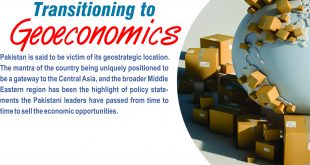China-Pakistan Economic Corridor (CPEC), a project pregnant and brimming with immense geopolitical and geo-economic dimensions, has even deeper geo-strategic connotations. It has already set forth a massive upheaval in the dynamics of the Af-Pak and South-Central Asian regions and portends even starker ramifications for the Indian Ocean/Arabian Sea region as well.
The United States, under President Donald Trump, is still dithering over its policy toward the Af-Pak region (APR). Whether it prolongs its stay or withdraws; either way it will have a profound impact on the region. However, newer players like China, Russia, Iran, Daesh/IS, etc., have since become perceptibly more proactive and assertive in this region. In addition, the CPEC too will have far-reaching implications for the entire region and beyond.
China is investing billions of dollars in Pakistan and Iran; it is, thus, inevitable that it will undertake all the measures (including military) necessary – in collaboration with both countries – to secure its interests in this region. Russia has proactively engaged Iran, Pakistan and other regional players including, reportedly, the Afghan Taliban to counter and defeat the evolving Daesh/IS threat in Afghanistan. Russia has also shown a desire to connect its Eurasian Economic Union project to the CPEC; thus confirming its ingress into the region and its drive to the Makran Coast/Arabian Sea. With China and Russia already proactive in the region, how far behind can an enlarged and further energized Shanghai Cooperation Organization (SCO) be?
This sets the scene then for a titanic clash of national interests between the US and India on the one hand, and the China-Russia-Iran-Pakistan (CRIP) combined, on the other. Multipolarity in the region seems to be crystallizing at a frenetic pace; economic and political compulsions along with the need to secure this evolving sphere of influence make the further militarization of the region a foregone conclusion!
Pakistan’s coastline, stretching from Jiwani in the west to Keti Bandar and beyond in the east, provides any force that develops it for military purposes with overarching strategic advantages. It offers multiple natural sites for ports, naval (in particular submarine), air and missile bases, radar and intelligence-gathering stations, communication centres, etc. It is a natural springboard to dominate the IOR/Arabian Sea complex. It provides an exceptional strategic reach to cover the SLOCs to and from the Persian Gulf, including the Hormuz Strait and also the Greater Middle East Region (GMER) at large. In addition, forces foraying forth from the Makran Coast can venture even deeper into the Indian Ocean for a critical oversight on the Bab-el-Mandeb chokepoint as well as the SLOCs to and from the east coast of Africa, Europe, the Mediterranean Sea-Suez Canal-Red Sea to the Far East and the Pacific Ocean. China has acquired a strategically situated “logistics” base in Djibouti as well. It seems to be securing the western extremities of the IOR/Arabian Sea complex. In fact, it will eventually have a crucial oversight on all East-West trade in the IOR. On the other hand, the US too has acquired a “military logistics” base on the western coast of India. It has also outsourced the maintenance of the ships of the US 7th Fleet to Reliance Defense, in Pipavav, in Gujarat state.
By moving on to Pakistan’s coastline, a deep strategic masterstroke in its own right, China has manoeuvred itself into a position of immense strategic advantages. In one fell swoop, it has outflanked India through Pakistan and largely neutralized US’ potentially debilitating stranglehold over the Malacca Strait chokepoint – much to their combined chagrin!
For the US, this Chinese manoeuvre has multiple strategic connotations. First, it brings China (and Russia) into an advantageous position in the Af-Pak region. Were it to egress from the APR, it would end up ceding critical space and influence to them. Second, if China were to develop military capabilities and trade corridors northwards along the Makran Coast, it would not only greatly neutralize the impact of the Malacca Strait bottleneck but would also act as a pull on the US military in the Asia Pacific by threatening its SLOCs to the Middle East and Europe. This would somewhat limit US engagement in the East and South China Seas and thereabouts. Third, it will put a lot of pressure on the US to ensure its ability to fight more than one major regional conflict simultaneously – that is, if it has to confront the Chinese in the East and South China Seas/Pacific Ocean as well as in the IOR/Arabian Sea theatres of war, at the same time. At the least, the US military effort will be divided between the two theatres of war. Fourth, the US will require the services of its allies like Japan, South Korea, Australia, India, etc., to counter China on the seas – off shore balancing again? Whereas South Korea, Japan and Australia could be assisting the US in the East and South China Seas/Pacific Ocean region, India could possibly be given the major responsibility of the Indian Ocean. But will the Indians be willing to die for Uncle Sam; though historically speaking they have done so for His Majesty the King of the Great Britain? Fifth, the Chinese could possibly block the Hormuz Strait (from the Makran Coast) and Bab-el-Mandeb (from Djibouti), thus sealing off both theatres of war from the ME, Europe and the Mediterranean, if and when required.
The IOR is now likely to get further nuclearized too at an increasingly hectic pace. It already has the Indian and US navies with their phenomenal arsenals – nuclear including – present in the region. Pakistan has recently demonstrated its nuclear triad capability. China will eventually show its presence in the IOR/Arabian Sea with competing military prowess. All this promises to make the overall strategic mix in the region even more potent, ominous and complex.
Thus the battle lines continue to be relentlessly drawn in the choppy waters of the Pacific Ocean and IOR/Arabian Sea complex – in what could possibly be the next two most likely theatres of war.
The CPEC appears to portend colossal strategic ramifications at the regional and global levels!
Highlights
- China is investing billions of dollars in Pakistan and Iran and Russia has also shown a desire to connect its Eurasian Economic Union project to the CPEC.
- Multipolarity in the region seems to be crystallizing at a frenetic pace.
- Pakistan’s coastline, stretching from Jiwani in the west to Keti Bandar and beyond in the east, provides any force that develops it for military purposes with overarching strategic advantages.
- The IOR is now likely to get further nuclearized too at an increasingly hectic pace.
- The Pacific Ocean and IOR/Arabian Sea complex could possibly be the next two most likely theatres of war.
Courtesy: The News International
By: Brigadier (Retd) Imran Malik
 Jahangir's World Times First Comprehensive Magazine for students/teachers of competitive exams and general readers as well.
Jahangir's World Times First Comprehensive Magazine for students/teachers of competitive exams and general readers as well.



